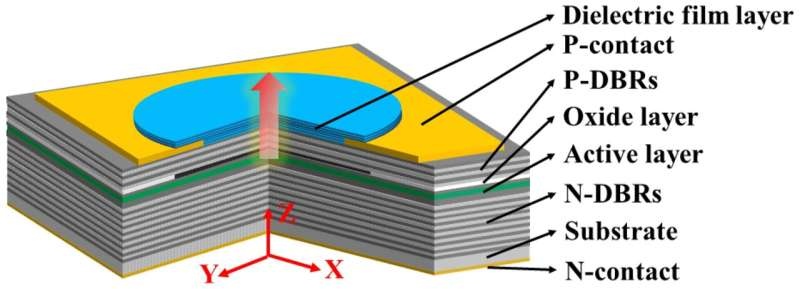Researchers have discovered a novel metal-dielectric film mode filter structure that can revolutionize the way we control transverse modes in vertical-cavity surface-emitting lasers (VCSELs), paving the way for high-power, single-mode devices with improved performance characteristics.

Overcoming VCSEL Limitations
Single-mode operation of traditional oxide-confined VCSEL suffers from high series resistance and low output power. This has been a big problem for researchers and developers of complex applications for quite some time. Scientists from the Changchun Institute of Optics, Fine Mechanics and Physics, Chinese Academy of Sciences have now released a new discovery that points to a possible solution.
To solve these issues, the researchers suggested a metal aperture mode filtering method with a high quality factor. To gain insights into the intricate interplay of metal and oxide apertures for optical field confinement and mode discrimination, a COMSOL developed finite element simulation model of a metal mode-filtered VCSEL (MMF-VCSEL) was evaluated.
How Metal Aperture Works Beyond its Potential
The modal control of MMF-VCSEL and then the simulation results showed that the number of P-Distributed Bragg Reflectors (P-DBR) pairs, metal aperture size, and oxide aperture size all had great impact on this property. However, for the devices with fewer numbers of P-DBRs, the transverse optical field was confined very much into lower index metal aperture and this confinement weakened as the number of P-DBRs increased.
Where more metal was placed between the oxide and inside illumination region (i.e., case 1), optical scattering increased as the distance decreased. This increased the mode discrimination and modal loss, both strongly promoting better single-mode stability. When the metal aperture is bigger than the oxide, however, the optical mode in the VCSEL is primarily governed by the oxide aperture.
They had also included a new parameter in the way of optical gain that represented the change in threshold gain for various transverse modes resulting from optical scattering by the structure. They found sweet spots in the design parameters that optimized ultimate single mode stability and slope efficiency of the MMF-VCSEL simultaneously via a balanced increase of both optical gain difference between modes and optical gain for the fundamental mode.
Conclusion
The invention of this metal mode-filtered VCSEL model structure by the applicants has advanced optical mode control for VCSELs significantly. The researchers have successfully shown high-power, single-mode VCSELs with controllable transverse mode. The study demonstrates the fundamental importance of confined spatial mode in VCSELs through metallic apertures, and paves the way for designing a wide range of applications from telecommunications to high-power optics with outstanding performance.
